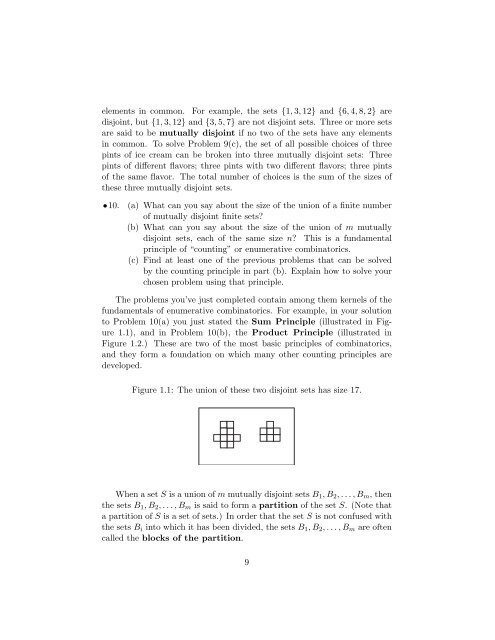DISCRETE MATHEMATICS THROUGH GUIDED DISCOVERY ...
DISCRETE MATHEMATICS THROUGH GUIDED DISCOVERY ...
DISCRETE MATHEMATICS THROUGH GUIDED DISCOVERY ...
You also want an ePaper? Increase the reach of your titles
YUMPU automatically turns print PDFs into web optimized ePapers that Google loves.
elements in common. For example, the sets {1, 3, 12} and {6, 4, 8, 2} are<br />
disjoint, but {1, 3, 12} and {3, 5, 7} are not disjoint sets. Three or more sets<br />
are said to be mutually disjoint if no two of the sets have any elements<br />
in common. To solve Problem 9(c), the set of all possible choices of three<br />
pints of ice cream can be broken into three mutually disjoint sets: Three<br />
pints of different flavors; three pints with two different flavors; three pints<br />
of the same flavor. The total number of choices is the sum of the sizes of<br />
these three mutually disjoint sets.<br />
•10. (a) What can you say about the size of the union of a finite number<br />
of mutually disjoint finite sets?<br />
(b) What can you say about the size of the union of m mutually<br />
disjoint sets, each of the same size n? This is a fundamental<br />
principle of “counting” or enumerative combinatorics.<br />
(c) Find at least one of the previous problems that can be solved<br />
by the counting principle in part (b). Explain how to solve your<br />
chosen problem using that principle.<br />
The problems you’ve just completed contain among them kernels of the<br />
fundamentals of enumerative combinatorics. For example, in your solution<br />
to Problem 10(a) you just stated the Sum Principle (illustrated in Figure<br />
1.1), and in Problem 10(b), the Product Principle (illustrated in<br />
Figure 1.2.) These are two of the most basic principles of combinatorics,<br />
and they form a foundation on which many other counting principles are<br />
developed.<br />
Figure 1.1: The union of these two disjoint sets has size 17.<br />
When a set S is a union of m mutually disjoint sets B1, B2, . . . , Bm, then<br />
the sets B1, B2, . . . , Bm is said to form a partition of the set S. (Note that<br />
a partition of S is a set of sets.) In order that the set S is not confused with<br />
the sets Bi into which it has been divided, the sets B1, B2, . . . , Bm are often<br />
called the blocks of the partition.<br />
9

















